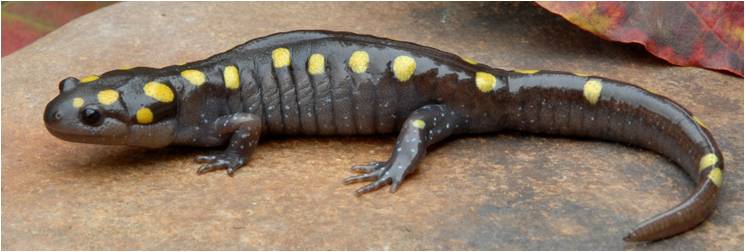Adaptation
The spotted salamander has acquired many adaptations throughout history as well as during its individual life. When
salamanders first hatch in a pond, they are adapted completely
for an aquatic environment. They hatch with external gills on the sides
of their heads, a tail, and no visible legs,
appearing similar to a minnow. They eat mainly zooplankton,
other larvae and aquatic insects . Over time legs develop and
they lose their external gills, along with an elongation and
thickening of the tail. As they mature, they start to look more
and more like an adult salamander. To learn
more about the reproduction and larval state,
click here. Once the larvae have completely developed they’re
set for a carnivorous terrestrial life style. Their eyes are
adapted to work best in low light levels, similar to the burrows
they hunt and reside in. If a salamander does venture out at
night and encounters another salamander or predator, it will
wave its tail above its head while secreting a milky toxin from
glands on its tail.
aquatic environment. They hatch with external gills on the sides
of their heads, a tail, and no visible legs,
appearing similar to a minnow. They eat mainly zooplankton,
other larvae and aquatic insects . Over time legs develop and
they lose their external gills, along with an elongation and
thickening of the tail. As they mature, they start to look more
and more like an adult salamander. To learn
more about the reproduction and larval state,
click here. Once the larvae have completely developed they’re
set for a carnivorous terrestrial life style. Their eyes are
adapted to work best in low light levels, similar to the burrows
they hunt and reside in. If a salamander does venture out at
night and encounters another salamander or predator, it will
wave its tail above its head while secreting a milky toxin from
glands on its tail.
Continue on to see what the salamander eats on the
nutrition page!
Go Back to
Home
